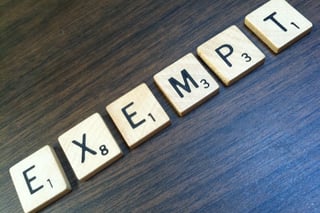 Financial difficulty brings with it a lot of distress. A person who is facing overwhelming debt is searching for ways to cope with, and eventually, overcome the financial challenges with which he or she is dealing. Many individuals dealing with the stress of debt that cannot be serviced look at bankruptcy as an option to resolve financial problems. But in considering whether to file a bankruptcy case, these individuals often worry about whether the property that they own whether it is real estate or personal property will be protected if the individual decides to file a bankruptcy case.
Financial difficulty brings with it a lot of distress. A person who is facing overwhelming debt is searching for ways to cope with, and eventually, overcome the financial challenges with which he or she is dealing. Many individuals dealing with the stress of debt that cannot be serviced look at bankruptcy as an option to resolve financial problems. But in considering whether to file a bankruptcy case, these individuals often worry about whether the property that they own whether it is real estate or personal property will be protected if the individual decides to file a bankruptcy case.
The answer to this most basic question of the potential bankruptcy client is complicated. The answer depends in part on whether the client is looking at filing a chapter 7 or chapter 13 bankruptcy case, and if a chapter 7, whether the clients owns homestead real estate with significant equity, or is a plaintiff in a case that involves injury to the person, or both. And, if filing a Chapter 7 and if the personal owns a home with significant equity, and/or has a personal injury case, has the potential client lived in Minnesota for at least two years? So as you can see, it’s not a simple answer. But let’s approach the issue of keeping property in a bankruptcy case that is, the law of bankruptcy exemptions by looking first at the "building blocks" of the exemption laws.
Opt In, or Opt Out?
The first issue is whether a person lives in a state that allows bankruptcy debtors to use section 522(d) of the Bankruptcy Code to protect property. State legislatures are given the power to determine this question. Fifteen states and the District of Columbia allow a bankruptcy debtor to use the Bankruptcy Code exemptions; thirty five states do not. Minnesota is an "optin" state; that is, in Minnesota, a bankruptcy debtor can choose to use section 522(d) of the Bankruptcy Code to protect property, or they can use "non bankruptcy" law, which includes state law and non bankruptcy code federal law.
Among neighboring states, Wisconsin is an optin state, like Minnesota. Iowa, North Dakota and South Dakota are optout states. In these states a bankruptcy debtor can only use state law, or federal non bankruptcy law to protect property.
Minnesota is an OptIn State
People who file a bankruptcy case in Minnesota have a choice between using bankruptcy law provisions, or non bankruptcy law provisions to protect their property. The Bankruptcy Code’s exemption statute is found in section 522 of the Code. Section 522 (b)(1) allows individuals to exempt their property from administration by the bankruptcy trustee through application of the Bankruptcy Code exemption provisions. This law has been in effect since the Bankruptcy Code was amended and reformed in 1978. Prior to that time, the "old" Bankruptcy Act bankruptcy debtors only the protection of state law exemptions to protect property.
In 1978, the committee appointed by Congress to look at revising bankruptcy law saw that many states were not updating their exemption provisions to keep pace with the realities of life. The committee recommended a change: codify exemptions in the Bankruptcy Code to allow uniform exemptions throughout the United States, with more "modern" provisions that would allow more bankruptcy debtors to retain the property needed to give the debtors a "fresh start" once the debtors received their bankruptcy discharge.
Congress liked the proposal and passed section 522(b)(1); however Congress gave the states an "out" if the state legislatures did not want bankruptcy debtors to use any other statute than state law to protect property Congress gave states the option of an "optout" found in section 522(b)(2). State legislatures could vote to restrict exemptions to only those allowed in state statutes. As noted above, 35 states followed this requirement.
So Minnesota is in a minority as an optin state. As such, Minnesota bankruptcy debtors have more flexibility in protecting property than debtors in most optout states. When a person is thinking of filing a bankruptcy in Minnesota, whether it is a chapter 7 liquidation bankruptcy or a chapter 13 repayment bankruptcy, it’s important for the client to know which exemption statute works best for that individual.
Exemptions in Chapter 7 Cases
Knowledge of exemptions is critically important in chapter 7 cases, since the chapter 7 bankruptcy trustee – the person who administers the bankruptcy estate is a "liquidating trustee." Simply put, the chapter 7 trustee has the ability to sell nonexempt property owned by a chapter 7 debtor, and use the proceeds of the sale to pay the debtor’s unsecured creditors.. So knowing what property is or is not protected by which exemption statute is very important for Minnesota bankruptcy debtors.
Exemptions in Chapter 13 Cases
The chapter 13 trustee is not a liquidating trustee. That means that an person who files a chapter 13 bankruptcy case will not have the chapter 13 trustee selling the debtor’s nonexempt property. But the knowledge of exemptions is still important to chapter 13 debtors, since the Bankruptcy Code requires that chapter 13 plans, in order to be confirmed by the court, must provide as much payment to the debtor’s unsecured creditors as these creditors would receive in a theoretical chapter 7 liquidation. The requirement to "pay" for nonexempt assets is called the best interests of creditors test. So even though chapter 13 debtors need not worry about a trustee taking control of their assets, these debtors must be mindful of the amount of nonexempt assets they own, since that amount, at least, must be paid into the chapter 13 plan for distribution to unsecured creditors.
What Property Is Exempt?
Comparing the Bankruptcy Code and State Law
Your Home
The exemption applies to both real and personal property that is used as a residence. This exemption thus covers mobile and modular homes that are not permanently attached to the land. The exemption places no limit on the amount of land an individual can exempt; rather, the exemption limits the amount of at can be exempted. If a married couple files a joint bankruptcy case, this exemption is doubled, to $47,350 in equity.
Minnesota state law allows debtors to exempt $390,000 in equity in real property owned and occupied by the debtor, and $900,000 for homestead property that is used primarily for agricultural purposes. There is an acreage limit to this exemption - 160 acres of property is subject to the exemption. It is not clear from the statute whether couples who file a joint bankruptcy case can double the exemption - nothing the statute says that it can be doubled, nothing says it can't. For bankruptcy purposes, this issue rarely comes up since a couple , say, $450,000 of equity in their home will usually seek a way to cash out a portion of their home equity to resolve debt issues, rather than filing a bankruptcy case. The acreage limitation means that owners of large amounts of land, in excess of the stereotypical farm on a quarter-section of land will be inhibited from filing a chapter 7 bankruptcy case, because of the likelihood that the chapter 7 trustee would liquidate a portion of the land owned by the debtor. Unlike the bankruptcy code, Minnesota law requires that the debtor own and occupy the home being claimed as exempt - there is no exemption for the home owned by the debtor, but the debtor's dependents, if the debtor does not reside there, herself.
The difference in the amount of the exemption between the bankruptcy code and Minnesota state law is significant, and is the single-biggest determiner of whether a bankruptcy debtor chooses to use the exemptions found in the bankruptcy code or the state law homestead exemption.
Your car
The two statutes are similar in that a debtor is only allowed one vehicle to exempt, and the exemption equity limit is modest, particularly in the bankruptcy code.
Your household goods and furnishings
Section 522(d)(3) provides an exemption for many different categories of personal property. Household goods, household furnishings, wearing apparel, appliances, books, animals, crops and musical instruments are all covered by this statute. There is a dollar limit with this statute: the maximum exemption is $600 in any one item of personal property, with the aggregate exemption capped at $12,625. The statute requires that the personal property exempted has to be held for the personal, family or household use of the debtor - so property the debtor holds for sale or to generate some sort of business income is not exempt under this statute.
Section 550.37 subd. 4a of Minnesota statutes allow a debtor to exempt all wearing apparel, one watch, utensils and foodstuffs. 4b allows a debtor to exempt household furniture, appliances, phonographs and radio and television receivers of the debtor and the debtor's family. There's a value limit in 4b: the maximum exemption is $10,350



